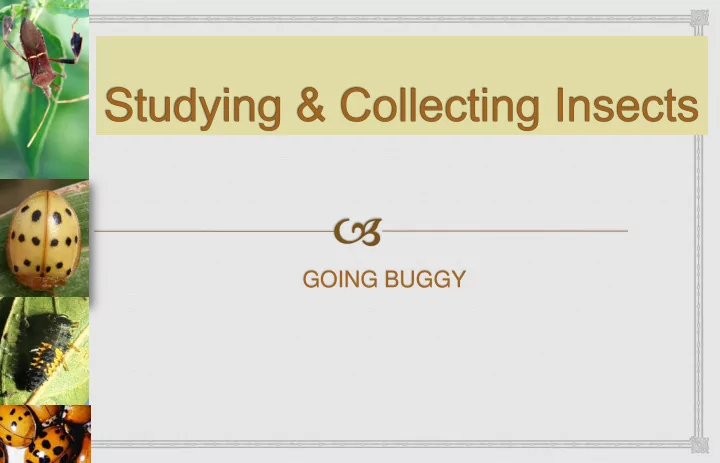

GOING BUGGY
Studying Insects with a Transect Many ways to studying insects same transect is walked at but here we will use a transect different times of the day line. different seasons of the Transects are used to determine year what animals live there. This way we can find out Can be used in different areas and be different sizes how the populations of depending on what info is species and the mix of needed about the habitat. species in a habitat changes
Studying Insects with a Transect
Tagging Monarchs Show the poster of tagged Each label has a unique number. When the monarch is recovered the number is monarch and explain that reported back to the scientists tracking right now the monarch the migration. They keep a large database of each butterfly is declining mostly location when and where each butterfly due to habitat loss. was tagged and when and where it was found again. To track the migration, By combining these locations the monarchs are caught and scientists can draw lines indicating the tagged with small paper migration path of the monarchs. tags which are stuck to their wings.
Tagging Monarchs
Where to collect Insects Collect insects from almost anywhere: plants, especially on flowers and leaves bark, stems, and branches in and around buildings under objects like rocks and logs ponds, lakes, streams, rivers, and bogs and.
Where would you look for Insects?
Ways to Collect Insects Aspirator Method Net Sweeping Sheet Trap for Tree Sweeping Aspirator Method
Ways to Collect Insects Sweeping: is done by moving a net back and forth through tall plants. This collects a variety of small insects that may otherwise be overlooked. pit fall traps: . A tin can or similar container is sunk into the ground so the top is even with the ground. A small hole is drilled into the bottom to prevent water from accumulating. A piece of old fruit or other type of material is placed as bait to attract insects. Different baits attract different insects. A fine-meshed screen is put over the bait to make it easier to remove insects Net Sweeping that fall into it. A cover is placed on top to prevent the trap from filling with moisture (in this case a plastic plate). Insects walking on the ground fall into the Aspirator Method container and become trapped (flying insects can escape). Aspirator: An aspirator is a small vacuum constructed of a glass tube, two-hole stopper, bent glass and hoses. Place the intake hose next to the insect. Inhale through the suction hose to pull the insect into the aspirator. Remove the insect from inside the aspirator. Sheet Trap: this method uses a collecting sheet spread over PVC pipes to hold the sheet open. Hold the open Sheet Trap for Tree sheet under tree branches or near shrubs and hit Sweeping Aspirator Method exposed branches with a stick to have hidden insects fall into the sheet.
Recommend
More recommend